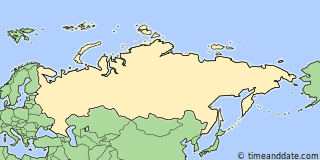2010年10月31日 (日), 3時00分
3月25日 (日)
Forward 1 hour
2007年3月25日 (日) - Daylight Saving Time Started
When local standard time was about to reach
2007年3月25日日曜日, 2時00分00秒 clocks were turned forward 1 hour to
2007年3月25日日曜日, 3時00分00秒 local daylight time instead.
Sunrise and sunset were about 1 hour later on 2007年3月25日 (日) than the day before. There was more light in the evening and less light in the morning.
Also called Spring Forward, Summer Time, and Daylight Savings Time.
10月28日 (日)
Back 1 hour
2007年10月28日 (日) - Daylight Saving Time Ended
When local daylight time was about to reach
2007年10月28日日曜日, 3時00分00秒 clocks were turned backward 1 hour to
2007年10月28日日曜日, 2時00分00秒 local standard time instead.
Sunrise and sunset were about 1 hour earlier on 2007年10月28日 (日) than the day before. There was more light in the morning and less light in the evening.
Also called Fall Back and Winter Time.
When Does DST Start and End in Russia?
Despite having used Daylight Saving Time (DST) for many years and as recently as 2010, Russia currently does not have DST.
DST First Introduced in 1917
The Soviet Union first experimented with DST in 1917, when clocks were turned forward by 1 hour. The measure was repealed only months later and, although the country's time zones underwent a number of changes in the years that followed, there was no official DST clock change from 1918 to 1980.
The USSR reintroduced DST in 1981. From 1984, the country changed its clocks simultaneously with most European countries. 2011 saw the nationwide introduction of year-round DST, ending a period of annual clock changes that had lasted for 3 decades. Following another law change in 2014, Russian clocks were turned back by 1 hour to today's all-year standard time.
Daylight Saving Time History in Russia
- Russia last observed Daylight Saving Time in 2010.
- Russia has observed DST for 41 years between 1916 and 2010.
- See Worldwide DST Statistics
